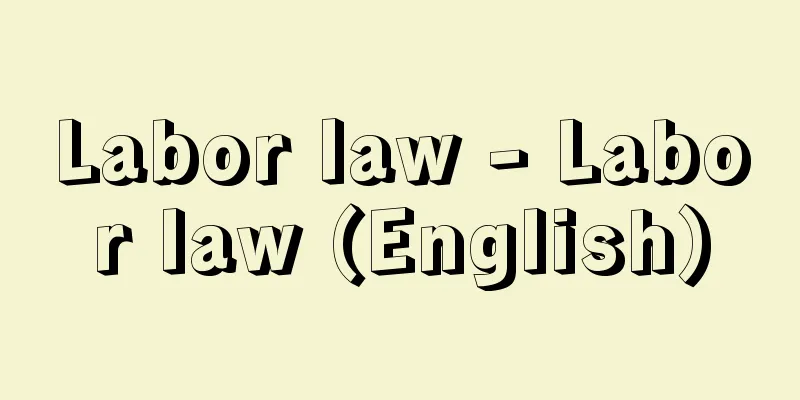Labor law - Labor law (English)

|
It refers to the totality of legal norms concerning the relationship between workers and employers. What is Labor Law?Today, many people earn a living by being employed and working. Whether or not they can get employment opportunities and how they are employed are important issues for how workers live their lives. Labor law refers to the whole set of laws that regulate the various issues that arise in the relationship between employed workers and their employers. Therefore, unlike civil law and criminal law, there is no single law called labor law. Labor law is composed of three areas: "labor market laws" such as the Employment Measures Act and the Employment Security Act; "individual labor relations laws" (labor protection laws) such as the Labor Standards Act, Labor Contract Act, and Minimum Wage Act; and "collective labor relations laws" (labor organization laws) centered on the Labor Union Act and the Labor Relations Adjustment Act. The common idea is to concretely guarantee the right to life or human dignity of workers who work and live in a capitalist society. [Hiroshi Terada] The Establishment and Development of Labor LawCivil Law and Labor RelationsHow one works is an important issue for people to live. Excessive work can sometimes lead to health damage and death. In particular, workers who are employed by an employer cannot decide how they work. Work style is decided by agreement (contract) with the employer, but due to the overwhelming difference in the balance of power between the two parties, the agreed work style is inevitably disadvantageous to the worker, that is, low wages and poor working conditions. The development of capitalism spreads such a method of deciding work style widely throughout society, and poverty of the working class becomes a serious social problem. In response to the widespread poverty of workers, two major movements have emerged to ensure a humane life for workers. One is a movement in which the state regulates the way workers work and establishes minimum standards for working conditions in order to protect workers. The other is a movement in which workers themselves unite in order to escape poverty and seek legal recognition of labor unions and their activities. These two major movements developed while influencing each other, and labor laws were born out of their influence. Labor law, whose main pillars are the protection of workers and the legal recognition of labor unions, can be said to have been born from the womb of modern civil law. The principle of civil law, which regards all people as free, equal, and equal citizens, freed from all status constraints, was excellent in that it liberated people from feudal status constraints and brought about the development of a capitalist society. However, when the three basic principles of civil law (= civil code), "absoluteness of private ownership," "freedom of contract," and "principle of negligence," are applied to the relationship between an employer and a worker who is employed by an employer and receives a wage (labor relationship), the labor relationship is also regarded as a contractual relationship (= employment contract) concluded by the free will of the equal worker and employer. And the employment contract that is concluded is binding on both the worker and the employer. When the principle that contracts are binding is applied to the economically unequal relationship between a worker and an employer, the worker is forced into an overwhelmingly disadvantageous position. This is because, unlike employers who own the means of production, workers cannot survive without selling (working) their own labor power every day, and in competition with many unemployed people looking for work, they have no choice but to accept poor and unfavorable working conditions. Regardless of the content of the wage or working conditions, once a contract is freely agreed upon, it is approved by civil law, and the result is profit for the employer and poverty for the worker. Moreover, employers have the right to freely use and dispose of the labor power thus purchased. Because labor power is a "commodity" that cannot be separated from the living laborer, the worker is forced to work under the command and orders of the employer. Thus, the relationship between the worker and the employer, which is free, equal, and equal as perceived by civil law, is transformed into one that is essentially unfree, unequal, and servile. Furthermore, freedom of contract meant that employers had the freedom to hire and terminate contracts (i.e. fire), and workers were constantly exposed to the difficulty of finding work and the threat of unemployment due to firing. For-profit employment agencies were involved in helping workers looking for work, and wage skimming and forced labor were rampant. The poor working conditions and long working hours that result from such employment relationships inevitably lead to frequent workplace accidents. However, when the principle of negligence in civil law is applied, workplace accidents are considered the worker's own responsibility, and it is extremely difficult for workers to seek compensation from their employers for health damage or loss of life caused by workplace accidents. Against the backdrop of this impoverishment of the working class, the labor union movement was born, seeking workers' survival and independence from employers. However, collective action to seek improvements in wages and working conditions was also considered illegal under civil law. The very unity of labor unions restricted the freedom of transactions between individual workers and employers, and collective actions such as strikes were strictly prohibited under civil law as violations of labor obligations under employment contracts and disruptive acts. The impoverished situation of the working class in the early stages of capitalist development was not resolved by the civil law of the time. The workers' movement for a better life forced the revision of the principles of civil law in two directions: the enactment of laws to protect workers and the enactment of laws to recognize the solidarity of workers. Thus, labor law was generated and developed in two directions. [Hiroshi Terada] The Origin and Development of Labor LawLabor Protection Laws aim to directly regulate working conditions through legislation. Labor Protection Laws set certain standards for working conditions and the workplace environment, and enforce their effectiveness by imposing supervisory systems and penalties, forcing employers to comply with them. After the first Factory Act was enacted in the UK in 1802, other countries also began to adopt such laws from the mid-19th century. Initially, it started out as beneficial and exceptional legislation aimed at minor and female workers in mines and factories, and its content was low-level, limited to working hours and safety and health, but the standards were gradually improved and the scope of application was expanded to include adult male workers, and the scope of regulations expanded to include holidays, vacations, and even minimum wages, covering all working conditions. Regarding industrial accidents, the "principle of fault liability" was revised. A workers' compensation system was established in which workers could receive a certain amount of compensation from their employers for accidents that occurred during the course of their work without having to prove the employer's negligence (no-fault liability), and this system was further developed into the workers' accident insurance system. In the 20th century, the government introduced a system of job placement and vocational training services to address the unemployment problem, provided unemployment insurance to the unemployed, and enacted laws to regulate commercial job placement businesses. Furthermore, legislation was enacted to restrict employers' right to dismiss employees. In Japan, the Factory Act was finally enacted in 1911 (Meiji 44), but its content remained low-level. Internationally, the International Labor Organization (ILO) was established in 1919, and efforts were made to establish and disseminate international labor standards. On the other hand, movements seeking recognition of workers' unity and freedom of trade union activity were initially thoroughly suppressed and severely punished by the state, but the trade union movement did not cease, and in the second half of the 19th century, laws banning unions were abolished in Europe and a policy of non-interference with unions was adopted, and in the 20th century, the country entered a stage of active recognition of unions. The active non-interference with unions policy, which consisted of (1) liberation from state oppression of unions and their activities, (2) elimination of employer interference in unions, and (3) elimination of civil law responsibility for unions and their activities, was realized in the 1919 Weimar Constitution in Germany, which guaranteed the right to unionize, and in the United States in 1935, the Wagner Act. In Japan, labor unions were under strict suppression until the end of World War II, but after Japan's defeat in 1945 (Showa 20), the old Labor Union Law made clear the liberation from this repressive system, and the following year, in 1946, Article 28 of the Constitution of Japan guaranteed the right to organize, the right to collective bargaining, and the right to collective action, which led to active recognition of labor unions. [Hiroshi Terada] Subjects and principles of labor lawSubject to labor lawAs we have seen, the labor law does not cover labor in general, but rather the relationship in which one is employed by another person, works, and receives a wage (i.e., wage labor). Labor law has used the concept of "dependent labor" to pursue the uniqueness of its subject matter. In this respect, labor law is considered to be a law concerning dependent labor. Labor law has been formed to recognize the fact that, while employers and workers as parties to an employment contract are legally free, equal, and equal agents, in reality workers have no choice but to be subordinate to their employers, and to mitigate the various ill effects that arise from this dependency. Subordinate labor is a concept that combines the elements of "economic dependency" and "class dependency," with the core concept of "personal dependency," which means that most workers are in a position where they have no choice but to provide labor by submitting to the commands and orders of their employers in the labor process. Economic dependency means that workers are in an overwhelmingly disadvantageous economic position vis-a-vis their employers even in the process of determining their working conditions, and class dependency means that workers are in a class position where they cannot maintain their own livelihood without being employed by an employer. Labor law is the law that applies to subordinate workers who are in such a subordinate labor relationship. The uniqueness of labor law is that it regulates the dependency of labor. Whereas civil law regards all people only as abstract individuals, labor law regards people as social entities who belong to some society and who are socially vulnerable and economically disadvantaged. The image of a person in labor law (= the image of a worker) is transformed from the abstract image of a person in civil law to a concrete image of a person as a "living person." Labor law also regards not only individual workers but also social groups such as labor unions as legal subjects, so that the social group of labor unions is legally recognized between the state and the individual, adding a collectivist element to the individualistic legal character of civil law. From the perspective of social law, which regards people as "social beings" in contrast to the individualistic "image of a person" in civil law, labor law, along with social security law, belongs to the field of social law. [Hiroshi Terada] Labor Law PhilosophyThe image of a human being and the image of a worker in labor law are linked to the basic principles of labor law. The principles of labor law, which look squarely at the work and life of workers in subordinate labor and aim to resolve the various problems that arise from it, aim to realize a "life worthy of a human being" for workers (Article 1, Paragraph 1 of the Labor Standards Act), and in that sense, the right to life (Article 25 of the Constitution) is the primary principle of labor law. For workers to aim for real autonomy, be involved in determining working conditions, and realize freedom and equality in a real sense, it is essential to realize not only the right to life but also the dignity of workers as human beings (Article 13 of the Constitution), and human dignity is also a guiding principle of labor law. [Hiroshi Terada] The form in which labor law existsThe form in which law exists is called a source of law, and refers to the norms that should serve as the standard of judgment for judges in court cases. Generally, statutory law is the most important source of law, but in the case of labor law, enforcement regulations are also important. In particular, since the provisions of the Labor Standards Act are general, the enforcement regulations play a large role in stipulating the detailed matters necessary for its implementation. In addition, interpretation rules such as instructions and circulars issued by the Ministry of Health, Labor and Welfare in the course of labor administration influence practical and judicial interpretations. There is debate as to whether precedents are a unique source of law, but they play an extremely important role in labor law. Labor-management disputes that arise every day are fluid and evolving, so there are limitations to how they can be addressed through legislation. Therefore, there are many cases where it is necessary to rely on precedents to deal with actual problems. It is for these reasons that the doctrine of abuse of the right to dismiss and the theory of the duty to take safety precautions are referred to as a type of case law. The Labor Contract Act, enacted in 2007, incorporates case law into legislation. The greatest feature of the source of labor law is that the legislation itself respects the voluntary establishment of norms by labor and management, such as work rules and labor agreements, and grants special legal effect, such as the normative effect of labor agreements (Article 16 of the Labor Standards Act). Because labor law is based on the premise that labor and management are in conflict with each other, it is not suited to uniform regulation by statutory law, and so the source of law is sought in such voluntary social laws. Not only voluntary social laws such as work rules, labor agreements, and labor union rules, but also labor practices are sources of law. The ILO Conventions and Recommendations, known as international labor law, are the unique source of labor law. Since its establishment in 1919, the ILO has adopted over 180 conventions, forming an international labor code and functioning as a "standard legislation" for countries around the world. Conventions become effective as a source of domestic law through ratification. However, considering that Japan has ratified only 48 conventions, the lowest number among developed countries, conventions that have been ratified by a large number of countries should be considered "established international law" (Article 98, paragraph 2 of the Constitution) or at least have the potential to be a source of law as a standard for interpreting laws, including the Constitution. In addition to the ILO, there are conventions, directives, judgments, reports, etc. adopted by international organizations such as the United Nations, the OECD (Organization for Economic Cooperation and Development), and the EU (European Union). Of these, the EU Labor Law, which was adopted with the formation of the EU, is particularly important as a form of regional labor law in the world. [Hiroshi Terada] Labor Law System, the Constitution, and International Covenants on Human RightsLabor law has been systematized around two areas: individual labor relations, which regulate the relationship between individual workers and employers, and collective labor relations, which regulate the relationship between collective activities of workers and employers (or employers' organizations). The former area is covered by individual labor relations laws (labor protection laws), which regulate the labor contracts and working conditions standards between individual workers and employers. In Japan, the laws include the Labor Standards Act, the Minimum Wage Act, and the Industrial Safety and Health Act. The latter area is called collective labor relations laws (labor organization laws), which regulate the formation, organization, and operation of labor unions, which are the solidarity of workers, as well as collective bargaining and dispute actions between labor unions and employers or their organizations. Examples of these laws include the Labor Union Act and the Labor Relations Adjustment Act. In addition to the labor law system consisting of these two areas, employment and unemployment issues were recognized as areas of law closely related to labor law during the low growth period triggered by the first oil crisis in 1973 (Showa 48), and a third independent area, the "employment security law" or "labor market law," was established. This covers the job-seeking and job-offering relationship between workers and employers before employment is established, and includes laws such as the Employment Measures Act, the Employment Security Act, and the Employment Insurance Act. Looking at the Japanese Constitution in terms of the labor law system, the Constitution, in terms of the "laws of the labor market" related to employment security and unemployment countermeasures, stipulates the right and obligation of the people to work in Article 27, paragraph 1, and guarantees the right to labor. In terms of "individual labor relations laws," Article 27, paragraph 2 of the Constitution orders the enactment of labor protection laws such as the Labor Standards Act and the Minimum Wage Act regarding "standards on wages, working hours, rest, and other working conditions." In terms of "collective labor relations laws," Article 28 of the Constitution guarantees workers' right to organize, right to collective bargaining, and right to collective action. Articles 27 and 28 are based on the idea of guaranteeing the people's right to life in Article 25 of the Constitution. The basic principle of guaranteeing the right to life is embodied in the principle of working conditions, which states that "working conditions must meet the needs of workers to live a life worthy of human beings" (Labor Standards Act, Article 1, paragraph 1), and serves as the guiding principle for the entire labor law. In international law, these three rights are guaranteed as part of social human rights provisions, and it is declared that these human rights derive from the inherent dignity of human beings. In other words, the Universal Declaration of Human Rights declares that "everyone has the opportunity to work, to choose freely his or her occupation, to have just and favorable conditions of work and to enjoy protection against unemployment" (Article 23, Paragraph 1), and further declares that "everyone has the right to organize and to join trade unions to protect his or her interests" (Article 23, Paragraph 4). In response to this, the International Covenant on Economic, Social and Cultural Rights guarantees to "everyone" the "right to the opportunity to earn a living by work which he or she freely chooses or accepts" (Article 6) and the "right to just and favorable conditions of work" (Article 7), and also recognizes the right to organize, such as the right to form and join trade unions (Article 8). This clarifies that all workers are guaranteed the right under the Employment Security Law to work under conditions such as employers and occupations that they can freely choose and approve without discrimination when seeking employment opportunities, and that when working for a certain employer, they are guaranteed the right under the Labor Protection Law to enjoy fair and favorable working conditions, and that all workers have the right to organize and take collective action to improve their economic and social status both in the labor market and in the workplace. Through the enjoyment of these rights, a life worthy of "human dignity" is sought. [Hiroshi Terada] Current status and issues of labor lawPostwar labor laws, which were formed and systematized based on the ideals of the Constitution, have developed under Japanese labor-management relations centered on large corporations since the period of high economic growth. Japanese employment practices, which are based on the three pillars of lifetime employment, seniority system, and company unions, have had a major impact on the interpretation and application of labor laws. However, after the end of high economic growth in the 1970s, these laws began to be reviewed. Against the backdrop of the long recession of the 1990s, Japanese labor-management relations underwent major changes, particularly after the Japan Federation of Employers' Associations (Nikkeiren) published "Japanese Management in a New Era" in 1995, which proposed a fundamental review of lifetime employment and seniority-based wages. These changes included: (1) a diversification of employment forms and changes in working styles due to an increase in part-time and temporary workers, (2) the hollowing out of long-term employment practices due to the forced dismissal and retirement of full-time employees in the name of restructuring, and (3) a tendency to emphasize ability and results over seniority in wages and personnel management. The government implemented structural reform and deregulation measures, and promoted deregulation of labor laws to encourage these management policies. These included the 1998 amendment to the Labor Standards Act (extending the maximum period for fixed-term contracts, introducing a discretionary labor system for planning work, etc.), the 1999 amendment to the Worker Dispatching Act (creating a negative list for dispatching work), the amendment to the Employment Security Act (liberalizing commercial employment placement in principle), and the second amendment to the Labor Standards Act and the amendment to the Worker Dispatching Act in 2003 (Heisei 15). These series of labor law revisions have significantly revised the basic principles of postwar labor law. The shift in management policy and deregulation of labor laws have created a large number of working poor, and Japanese society, once known as "one hundred million middle class," has suddenly seen an increase in the poverty rate and a widening gap between rich and poor, falling into a society of serious inequality. The biggest factor behind the widening gap is the widening gap between workers, such as the increase in non-regular workers, whose wages are overwhelmingly lower than those of regular workers, and the widening gap between non-regular workers. In order to correct this gap between workers, the Part-time Labor Law (now the Part-time and Fixed-Term Employment Law) and the Minimum Wage Law were revised in 2007, and in response to calls for stricter regulations on labor dispatching, such as disguised dispatching, the Labor Dispatch Law was revised in 2012. However, the crucial ban on registered dispatching and manufacturing dispatching has been postponed. On the other hand, there is also a demand for stricter regulations on violations of the law, such as the harsh and abnormally long working hours and "fake management positions," for traditional regular employees. In response to this, there are strong calls from corporate executives for further deregulation in order to survive the corporate competition caused by economic globalization. In this context, labor law is being forced to reexamine its scope of application and basic structure, while at the same time addressing important issues such as how to guarantee and realize the rights of women, the elderly, foreign workers, and people with disabilities. [Hiroshi Terada] "Labor Law Dictionary," edited by Numata Inejiro (1979, Labor Junposha)" ▽ "Introduction to Labor Law, by Numata Inejiro (1980, Seirin Shoin Shinsha)" ▽ "Individuals and Groups in Labor Law, by Nishitani Satoshi (1992, Yuhikaku)" ▽ "Lecture Series: Labor Law in the 21st Century," edited by the Japan Labor Law Association, 8 volumes (2000, Yuhikaku)" ▽ "Issues in Labor Law, edited by Kunishige Kakuta, Katsutoshi Kezuka, and Mutsuko Asakura, 3rd Edition (2004, Yuhikaku)" ▽ "Modern Labor Law and the Concept of the Worker, by Yanagiya Takayasu (2005, Shinzansha)" ▽ "Basic Labor Law, 2nd Edition, Expanded Edition, by Hamamura Akira (2006, Yuhikaku)" ▽ "Labor Law, 8th Edition, by Kanno Kazuo (2008, Kobundo)" ▽ "Labor Law" by Nishitani Satoshi (2008, Nippon Hyoronsha)" ▽ "Introduction to Labor Law" by Sotoo Kenichi, 7th edition (2009, Yuhikaku)" ▽ "Labor Law" by Araki Hisashi (2009, Yuhikaku)" ▽ "Watching Labor Law" by Tsuchida Michio, Toyokawa Yoshiaki, and Wada Hajime, 3rd edition (2009, Yuhikaku)" ▽ "Labor Law" by Shimoi Takashi, 4th edition (2009, Yuhikaku)" ▽ "The World of Labor Law" by Nakakubo Yuya, Noda Susumu, and Wada Hajime, 9th edition (2011, Yuhikaku)" ▽ "Labor Law" by Asakura Mutsuko, Shimada Yoichi, and Mori Seigo, 4th edition (2011, Yuhikaku)" ▽ "Let's Think About Labor Justice -- What We Can See from Labor Case Laws" by Ouchi Shinya (2012, Yuhikaku)" ▽ "Labor Law" by Yuichiro Mizumachi, 4th edition (2012, Yuhikaku)" ▽ "Introduction to Labor Law" by Yuichiro Mizumachi (Iwanami Shinsho)" ▽ "Employment and Labor Law in Japan" by Keiichiro Hamaguchi (Nikkei Bunko) [Reference items] | | | | | | | | | | | | | Industrial | | | | | | | | | | agreement | Labor | Labor | | | | | |Source: Shogakukan Encyclopedia Nipponica About Encyclopedia Nipponica Information | Legend |
|
労働者の使用者に対する関係にかかわる法規範の総体をいう。 労働法とは何か今日、多くの人は雇用されて働いて、報酬を得ることで生活している。雇用の機会を得ることができるかどうか、どのように雇用されるかは、働く者がどのように生きていくか、にとって重大な問題である。労働法は、このように雇用されて働く労働者と雇用する側の使用者との関係をめぐり生じる諸問題を規整する法の総体をいう。したがって、民法や刑法などとは異なり、労働法という名の単一の法律があるわけではない。労働法は、雇用対策法、職業安定法などの「労働市場の法」、労働基準法および労働契約法、最低賃金法などの「個別的労働関係法」(労働保護法)、労働組合法、労働関係調整法を中心とする「集団的労働関係法」(労働団体法)、の三つの分野から構成されるが、その共通した理念は、資本主義社会において労働・生活する労働者の生存権あるいは人間の尊厳の具体的保障にある。 [寺田 博] 労働法の成立と展開市民法と労働関係どのような働き方をするかは、人が生きていくうえで切実である。過重な労働はときとして健康破壊や死につながる。ことに使用者に雇用されて働く労働者にとっては、働き方を自分で決めることはできない。使用者との合意(=契約)によって働き方は決定されることになるが、両者の力関係の圧倒的な相違によって合意される働き方の内容は労働者に不利なもの、すなわち低賃金と劣悪な労働条件にならざるをえなくなる。資本主義の発展は、そうした働き方の決定方式を社会に広く及ぼし、労働者階級の貧困は深刻な社会問題となる。社会的に広汎に広がっていく労働者の貧困に対して、労働者の人間的な生活を確保しようとする二つの大きな動きが生まれてくる。一つは、労働者保護のために国家が労働者の働き方を規制し、労働条件の最低基準を定立する動きであり、もう一つは、貧困からの脱出を目ざして労働者自身が団結し、労働組合とその活動の法的承認を求める動きである。 この二つの大きな動きは、互いに影響を及ぼしながら発展し、その運動に押されて労働法は生まれてくる。 労働者保護と労働組合の法的な承認を主たる柱とする労働法は、近代市民法の胎内から生まれてきたということができる。すべての人間をいっさいの身分的拘束から解放された自由・平等・対等な市民としてとらえる市民法の原理は、封建的な身分的拘束から人々を解放し、資本主義社会の展開をもたらしたという面においては優れたものであった。しかし、市民法(=民法)が掲げる三つの基本原則、「私的所有権の絶対性」、「契約の自由」、「過失責任主義」は、使用者のもとで雇用されて働き、賃金を受け取る労働者と使用者の関係(労働関係)に適用されたとき、労働関係も対等・平等な労働者と使用者の自由な意思によって結ばれた契約関係(=雇用契約)としてとらえる。そして、締結された雇用契約は、労働者と使用者の双方を拘束することになる。契約は拘束する、という原則が労働者と使用者という経済的には不平等な関係に適用されると、労働者は圧倒的に不利な立場に追いやられる。なぜなら、生産手段を所有する使用者とは異なり日々自己の労働力を売らなければ(働かなければ)生活できない労働者は、仕事を求めるたくさんの失業者との競争もあって、どのような劣悪で不利な労働条件であったとしても受け入れざるをえない。どのような内容の賃金であれ労働条件であれ、いったん自由な意思によって合意された契約は、市民法では是認され、その結果は使用者には利潤を、労働者には貧困をもたらす。しかも、使用者はそのように購入した労働力を自由に利用し、処分できる権利をもつ。労働力は生きた労働者と切り離すことができない「商品」であるがゆえに、労働者は使用者の指揮命令のまま働くことを余儀なくされる。こうして、市民法のとらえる自由・平等・対等な労働者と使用者の関係は、実質的には不自由・不平等・隷属な関係に転化する。 さらに、契約の自由は使用者の採用の自由、契約の解約(=解雇)の自由を意味し、労働者は絶えず求職の困難や解雇による失業の脅威にさらされた。職を求める労働者には、営利職業紹介業が介在し、賃金のピンはねや強制労働が横行した。 こうした雇用関係のもとでの劣悪な労働条件や長時間労働による労働者の酷使は、必然的に労働災害の多発をもたらす。しかし、ここでも市民法の過失責任の原則が適用されると労働災害は労働者の自己責任とされ、労働者が労働災害で被った健康被害、生命の喪失への補償を使用者に求めることもきわめて困難であった。 このような労働者階級の窮乏化を背景に、労働者の生存と使用者からの自律を求める労働組合運動が生まれてくる。しかし、賃金や労働条件の改善を求める団結活動も、市民法により違法な存在とみなされる。労働組合という団結そのものが、個々の労働者と使用者の間の取引の自由を制限するものとして、ストライキのような団体行動は雇用契約上の労働義務違反や業務阻害行為として、市民法により厳しく禁圧された。 資本主義発展の初期の段階における労働者階級のこうした困窮の状況は、当時の市民法のもとでは解決されることはなかった。よりよい生存を求める労働者の運動は、二つの方向で市民法原理の修正を迫ることとなった。労働者保護のための法の制定と、労働者の団結承認の法の制定である。こうして労働法は二つの方向で生成し、展開することとなった。 [寺田 博] 労働法の生成と展開労働条件について法律による直接的な規制を目ざしたものが労働者保護法である。労働者保護法は、労働条件や職場環境について一定の基準を定め、その実効性を確保するために監督制度や罰則を適用して、その遵守を使用者に強制するものである。 1802年、イギリスで最初の工場法が制定されて以降、19世紀中ごろからその他の国でも展開をみる。当初は、鉱山や工場における年少者や女性労働者を対象とする恩恵的・例外的な立法としてスタートし、内容も労働時間や安全衛生などに限定された低水準のものであったが、その後しだいに基準が改善され、適用対象も成人男子労働者にも拡大し、規制の領域も休日・休暇、さらには最低賃金へと労働条件全体に及ぶものとなる。 労働災害については、「過失責任の原則」が修正される。労働者の業務上の災害に対しては、使用者の過失の立証を要せずに(無過失責任)使用者から一定額の補償を受けることのできる労災補償制度が樹立され、それはさらに労災保険制度に発展する。 20世紀になると、失業問題に対して国の職業紹介や職業訓練サービス制度が導入され、失業者に対して失業保険を給付し、営利職業紹介事業を規制する法が制定された。さらに解雇に対しては使用者の解雇権を規制する立法も成立する。 日本では、1911年(明治44)になってようやく工場法が制定されるが、内容的には低水準のものにとどまった。国際的には、1919年にILO(国際労働機関)が設立され、国際的な労働基準の形成と普及が図られることとなる。 他方、労働者の団結の承認、労働組合活動の自由を求める運動は、当初、国家により徹底的に弾圧され、厳しく処罰されたが、それでも労働組合運動はやまることなく、19世紀の後半にはヨーロッパで団結禁止法制が廃止され、団結の放任政策がとられ、20世紀になると積極的に団結を承認するという段階に入る。(1)労働組合とその活動に対する国家的な抑圧からの解放、(2)労働組合に対する使用者の干渉の排除、(3)労働組合とその活動に対する市民法上の責任の排除、を内容とする積極的団結放任政策は、1919年のドイツ・ワイマール憲法による団結権の保障、1935年のアメリカのワグナー法において現実化された。 日本では、第二次世界大戦の終了まで労働組合は厳しい禁圧体制のもとに置かれていたが、敗戦後の1945年(昭和20)、旧労働組合法が抑圧体制からの解放を鮮明にし、翌1946年の日本国憲法第28条で団結権、団体交渉権、団体行動権が保障されたことで、労働組合に対する積極的承認が実現した。 [寺田 博] 労働法の対象と理念労働法の対象労働法が対象とする労働は、みてきたように、労働一般ではなく、あくまでも他人に雇用されて労働し、賃金を支払われる関係(=賃労働関係)である。労働法がその対象の独自性を追求するために用いてきたのが「従属労働」の概念である。この点で労働法は従属労働に関する法とされる。 労働法は、雇用契約の当事者としての使用者と労働者が法的には自由・平等・対等な主体とされながらも、現実には労働者が使用者に従属せざるをえないことを法的事実として承認し、その従属性から生ずるさまざまな弊害を緩和するものとして形成されてきた。従属労働とは、労働者の多くが労働過程において使用者の指揮命令に服従して労務を提供せざるをえない地位にあること、すなわち「人的従属性」を中核として、さらにこれに「経済的従属性」と「階級的従属性」の要素を結び付けた概念である。経済的従属性とは、労働者が労働条件決定過程においても使用者に対して圧倒的不利な経済的立場に置かれていること、階級的従属性とは使用者に雇用されることなくして労働者は自己の生活を維持できない階級的な地位にあることを意味する。労働法は、このような従属労働関係のもとに置かれている従属労働者に適用される法である。労働法の独自性は、労働の従属性を規制対象とする点にある。 労働法における「人間像」は、市民法がすべて人を抽象的個人としてのみとらえたのに対して、なんらかの社会に帰属し、社会的弱者、経済的困窮者という立場にある社会的実在としてとらえる。労働法の人間像(=労働者像)は、市民法の抽象的人間像から、いわば「生きた人間」としての具体的人間像へと転化する。労働法ではまた、労働者個人のみならず、労働組合という社会的集団も法主体としてとらえることから、国家と個人との間に労働組合という社会集団も法認され、市民法の個人主義法的性格に集団主義的な要素が加えられている。市民法の個人主義的「人間像」に対置して「社会的存在」としての人間像をとらえる社会法という視座からは、労働法は社会保障法とともに社会法の法分野に属する。 [寺田 博] 労働法の理念労働法の人間像、労働者像は労働法の基本理念と結び付く。従属労働のもとに置かれた労働者の労働と生活を直視してそこから派生する諸問題の解決を目ざす労働法の理念は、労働者の「人たるに値する生活」(労働基準法1条1項)の実現を目ざすものであり、その意味では、生存権(憲法25条)こそがまず労働法の主たる理念となる。労働者が実質的な自律を目ざし、労働条件の決定に関与し、実質的な意味での自由・対等を実現していくためには、生存権にとどまらず、労働者の人間としての尊厳(憲法13条)の実現が不可欠であり、人間の尊厳も労働法の指導理念となる。 [寺田 博] 労働法の存在形式法の存在形式のことを法源といい、裁判において裁判官の判断基準となるべき規範を意味する。一般には制定法が法源のうちでもっとも重要であるが、労働法の場合には施行規則も重要である。とくに労働基準法の規定は大綱的なものであるから、その施行のために必要な細目的事項を定める施行規則の役割は大きい。また、厚生労働省が労働行政の実際にあたり発する訓令、通牒(つうちょう)などの解釈例規は、実務上、裁判上の解釈に影響を与えている。 判例が独自の法源かどうかについては議論があるが、労働法において判例はきわめて重要な役割を果たしている。日々発生する労使紛争は流動的、発展的であるため、立法による対応には限界がある。したがって実際の問題処理について判例に依拠せざるをえない場合が多い。解雇権濫用法理や安全配慮義務理論が一種の判例法とよばれるのも、こうした事情による。2007年(平成19)に制定された労働契約法は、判例法を立法に取り込んだものである。 労働法の法源の最大の特色は、就業規則や労働協約のような労使による自主的な規範の設定を立法自体が尊重し、労働協約の規範的効力(労働基準法16条)のように特別な法的効力を付与していることにある。労働法が基盤とするのは労使が対抗する場であることから、制定法で画一的に規制することに適さず、こうした社会的自主法に法源を求めたのである。就業規則や労働協約、労働組合規約などの社会的自主法のみならず、労働慣行もまた法源となる。 労働法に固有な法源として、国際労働法とよばれるILO条約(国際労働条約)・勧告がある。1919年の創設以来、ILOの採択した条約は180を超え、国際労働法典を形成し、世界各国の「基準的立法案」として機能している。条約は批准によって国内法の法源としての効力をもつことになる。しかし、日本の条約批准数が48と先進国のなかでは最低レベルにあることを考慮すると、多数の国により批准された条約は「確立された国際法規」(憲法98条2項)として、さもなければ、少なくとも憲法を含む法規の解釈基準としての法源性をもつべきと解される。ILOのほかにも国際連合、OECD(経済協力開発機構)、EU(ヨーロッパ連合)などの国際機関の採択した条約、指令、判決、報告などがある。このうち、とりわけEUの結成に伴うEU労働法は、世界のなかの地域的労働法の形成として重要である。 [寺田 博] 労働法の体系と憲法・国際人権規約労働法は、個々の労働者と使用者の関係を規律する個別的労働関係、労働者の集団的活動と使用者(または使用者団体)との関係を規律する集団的労働関係、の二つの領域を中心に体系化が図られてきた。前者の領域をカバーするものが個別的労働関係法(労働保護法)で、個々の労働者と使用者の間の労働契約や労働条件基準などを規律する。日本の制定法としては、労働基準法を中心に最低賃金法、労働安全衛生法などがある。後者は集団的労働関係法(労働団体法)とよばれ、労働者の団結体である労働組合の結成、組織、運営および労働組合と使用者またはその団体との団体交渉、争議行為などを規整する。労働組合法、労働関係調整法などがこれにあたる。この二つの領域からなる労働法の体系に加えて、1973年(昭和48)の第一次石油危機を契機とする低成長下で雇用・失業問題が労働法に密接に関連する法の領域と意識され、「雇用保障法」ないし「労働市場の法」という独立した第三の領域が確立された。これは、雇用が成立する以前の労働者と使用者の求職・求人関係を対象とし、雇用対策法、職業安定法、雇用保険法などの法が含まれる。 労働法の体系に即して日本国憲法をみると、雇用保障や失業対策に関する「労働市場の法」については、憲法は第27条1項において国民の勤労の権利および義務を定め、労働権を保障する。「個別的労働関係法」は憲法第27条2項が「賃金、就業時間、休息その他の勤労条件に関する基準」について、労働基準法や最低賃金法などの労働保護法の制定を命じている。「集団的労働関係法」については、憲法第28条が勤労者の団結権、団体交渉権、および団体行動権を保障している。27条、28条の基礎には、憲法第25条の国民の生存権保障の理念がある。生存権保障の基本原則は「労働条件は、労働者が人たるに値する生活を営むための必要を充たすべきものでなければならない」(労働基準法1条1項)という労働条件原則で具体化され、労働法全体の指導原理となっている。 国際法についてみると、これら三つの領域の権利は社会的人権規定の一環として保障され、これらの人権が人間に固有の尊厳に由来するものであることが宣明されている。すなわち、世界人権宣言は「すべて人は、労働し、職業を自由に選択し、公正かつ有利な労働条件を確保し、及び失業に対する保護を受ける機会を有」(23条1項)し、さらに「すべて人は、自己の利益を保護するために労働組合を組織し、及びこれに加入する権利を有する」(同条4項)と宣言する。これを受けて、国際人権規約A規約「経済的、社会的及び文化的権利に関する国際規約」は、「すべての者」に「自由に選択し又は承諾する労働によって生計を立てる機会を得る権利」(6条)と「公正かつ良好な労働条件を享受する権利」(7条)を保障し、かつ労働組合を結成し、加入する権利などの団結権(8条)を認める。これは、すべての労働者に、雇用の機会を求める場合には、なんらの差別もなく、自由に選択し承認できる使用者・職種などの条件のもとで働く雇用保障法上の権利が、また一定の使用者のもとで労働する場合には、公正かつ有利な労働条件を享受する労働保護法上の権利が保障されていること、さらにすべての労働者が、労働市場においても、あるいは雇用関係の場においても、その経済的・社会的地位向上のために団結し団体行動する権利を有することを明らかにしている。そして、こうした権利の享受を通して「人間の尊厳」に値する生存が志向されているのである。 [寺田 博] 労働法の現状と課題憲法の理念のもとに形成、体系化されてきた戦後労働法は、高度経済成長期以降の大企業を中心とした日本的労使関係のもとで展開する。終身雇用、年功制、企業内組合を三つの柱とする日本的雇用慣行は労働法の解釈、運用に大きな影響を与えた。しかし、高度経済成長の終わる1970年代以降、その見直しが進められる。 1990年代の長期不況を背景に、ことに1995年(平成7)の日経連(日本経営者団体連盟)の「新時代の日本的経営」が終身雇用、年功序列賃金について抜本的な見直しを提言したことを契機として、日本的労使関係は大きく変質し、(1)パート・派遣労働者などの増加による雇用形態の多様化、働き方の変化、(2)リストラの名のもと正社員の解雇・退職の強要による長期雇用慣行の空洞化、(3)賃金・人事管理における年功よりも能力・成果を重視する傾向、などが顕著となる。 国は構造改革、規制緩和策をとり、こうした経営政策を助長するために労働法の規制緩和を推し進める。1998年の労働基準法改正(有期契約の上限期間の延長、企画業務型裁量労働制の導入など)、1999年の労働者派遣法改正(派遣業務のネガティブリスト化)、職業安定法改正(営利職業紹介の原則自由化)、2003年(平成15)の労働基準法再改正、労働者派遣法の改正、などである。 こうした一連の労働法改正によって、戦後労働法の基本原則は大きく修正された。経営政策の転換と労働法制の規制緩和は大量のワーキングプア層を生み出し、かつて、「一億総中流」といわれた日本社会は、一挙に貧困率が増大し、貧富格差が広がり、深刻な格差社会へと転落した。格差拡大をもたらした最大の要因は、正規労働者に比べ賃金が圧倒的に低い非正規労働者の増加や非正規労働者間の格差の拡大など、労働者間の格差拡大にある。このような労働者間格差を是正するために、2007年のパート労働法(現、パートタイム・有期雇用労働法)や最低賃金法の改正がなされ、また、偽装派遣などに対する労働者派遣の規制強化を求める声に応じた形で、2012年に労働者派遣法が改正された。しかし、肝心な登録型派遣や製造業派遣禁止は見送られている。他方、従来の正社員労働者に対しても、その過酷で異常な長時間労働や「偽装管理職」などにみられる法の逸脱に対する規制の強化も求められている。これに対し、企業経営者の側からは、経済のグローバル化による企業間競争を生き残るために、さらなる規制緩和を求める声も強い。 こうしたなかで、労働法は従来の適用範囲や基本構造について再検討を迫られている。同時に、女性、高齢者、外国人労働者、障害者などの権利をどのように保障・実現するか、という重要な課題の解決も迫られている。 [寺田 博] 『沼田稲次郎編『労働法事典』(1979・労働旬報社)』▽『沼田稲次郎著『労働法入門』(1980・青林書院新社)』▽『西谷敏著『労働法における個人と集団』(1992・有斐閣)』▽『日本労働法学会編『講座・21世紀の労働法』全8巻(2000・有斐閣)』▽『角田邦重・毛塚勝利・浅倉むつ子編『労働法の争点』第3版(2004・有斐閣)』▽『柳屋孝安著『現代労働法と労働者概念』(2005・信山社)』▽『浜村彰著『ベーシック労働法』第2版増補版(2006・有斐閣)』▽『菅野和夫著『労働法』第8版(2008・弘文堂)』▽『西谷敏著『労働法』(2008・日本評論社)』▽『外尾健一著『労働法入門』第7版(2009・有斐閣)』▽『荒木尚志著『労働法』(2009・有斐閣)』▽『土田道夫・豊川義明・和田肇著『ウォッチング労働法』第3版(2009・有斐閣)』▽『下井隆史著『労働法』第4版(2009・有斐閣)』▽『中窪裕也・野田進・和田肇著『労働法の世界』第9版(2011・有斐閣)』▽『浅倉むつ子・島田陽一・盛誠吾著『労働法』第4版(2011・有斐閣)』▽『大内伸哉著『労働の正義を考えよう――労働判例からみえるもの』(2012・有斐閣)』▽『水町勇一郎著『労働法』第4版(2012・有斐閣)』▽『水町勇一郎著『労働法入門』(岩波新書)』▽『浜口桂一郎著『日本の雇用と労働法』(日経文庫)』 [参照項目] | | | | | | | | | | | | | | | | | | | | | | | | | | | | | | |出典 小学館 日本大百科全書(ニッポニカ)日本大百科全書(ニッポニカ)について 情報 | 凡例 |
<<: Model Laborer - ousou mohan (English spelling)
Recommend
Swiss bank - Swissginkou (English spelling) Swiss bank
There is a bank with the same name, but the term i...
Silistria
…A city in northern Bulgaria, on the border with ...
Community Sports
It can be thought of as a general term for the for...
Musical rhythm - Gakuritsu
〘 noun 〙 The name of the musical scale used in tra...
Wood chips
Wood such as cedar, cypress, and pine is shaved i...
Kidal (English spelling)
A city in northeastern Mali. The capital of Kidal ...
Kanazu [town] - Kanazu
A former town in Sakai County, straddling the Fuku...
Hepatic coma
This refers to impaired consciousness caused by s...
Red Line/Blue Line
Administrative divisions established by instructio...
Craniopharyngioma
...Among these diencephalic tumors, the main ones...
Amol (English spelling)
...Because of its political insignificance, Islam...
Pasteur
…For these reasons, sheep are generally considere...
Altus [river] - Altus
The river originates from the Hasmash-Mare mounta...
Statue of a god
The gods of Jingi faith are depicted in sculpture...
Gilson, P.
…Especially noteworthy are the musicological achi...









